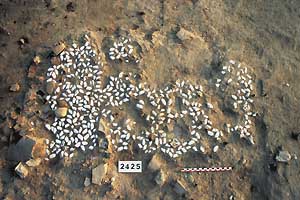Professor, colleagues discover 10 examples of 2000-year-old Celtic art
By William HarmsNews Office
 Ancient people used shells to create an unusual form of art on the floors of their homes at a site near the Mediterranean. Michael Dietler, Associate Professor in Anthropology, uncovered the artwork. |
The 2,000-year-old artwork includes a two- and one-half-foot-long image of a horse or donkey and was discovered on the floors of homes at the site, said Dietler. In all, 10 examples have been found, including some pieces with shell arrangements in rectangles. The work is displayed in a museum adjacent to the site, Lattes, an ancient port settlement five miles south of the modern city of Montpellier.
The art is the product of the town’s Celtic-speaking inhabitants, who had recently been conquered but not yet totally dominated by the Romans. The artwork seems to have been executed during a 50-year period in the late second and early first centuries B.C. and is found only in one neighborhood of the town.
The purpose of the artwork is unclear. No other examples of similar work have been found; however, its nature makes it extremely perishable.
 The photo above shows another example of the shell art found at Lattes by Associate Professor Michael Dietler. |
The shells are from tellines, a bi-valve shellfish, which the people of that time ate and which are still harvested in the Mediterranean and eaten by people in southern France.
In order to construct the art, the Celts opened the shells, which are about half an inch across, and placed them on the dirt floors of their houses. Successive generations covered the shell art with new dirt as they made new floors for their homes and the art was accordingly preserved.
“We were able to find the artwork because of the type of technique we use in excavation,” Dietler said. “We carefully excavate large horizontal surfaces, following thin stratigraphic levels within rooms, rather than digging very deeply into the site in small pits or trenches. If we hadn’t done that, we probably would have just dug up the shells and recorded them as food remains and never seen the art.”
Lattes is an important site for understanding the Iron Age in the western Mediterranean and the history of ancient Greek and Roman colonialism. It was occupied from the sixth century B.C. to the second century A.D., at which time the lagoon that connected it to the Mediterranean filled with silt and residents gradually abandoned the community.
The site, which was known as Lattara in ancient times, was rediscovered in the 1970s as a result of urban expansion from Montpellier. After initial archaeological exploration showed that there was an important site in the area, it was preserved and a major museum and archaeological research complex was built on the edge.
French researchers, who are joined by Dietler and colleagues from Spain and Italy, conduct an annual excavation of the site, which also is an international field school for graduate students. They have revealed, in addition to the unique shell art, other unusual features of the community.
Lattes is one of the largest sites in the region, covering 75 acres at its fullest extent of expansion. Unlike other communities of the period, it was a fortified lowland site rather than a hill fort, most of which were much less than half its size.
The port was an important gateway to the Celtic residents of the interior and connected them with Etruscan and Greek trade goods. Outside the Greek colony at Marseille, Lattes has the first evidence of olive oil and wine production in France.
“It is a place that allows us to study in fine deatil the processes of cultural borrowing and hybridization that were ultimately responsible for the formation of western European cultures, generally at the dawn of the historical era,” said Dietler.
![[Chronicle]](/images/small-header.gif)